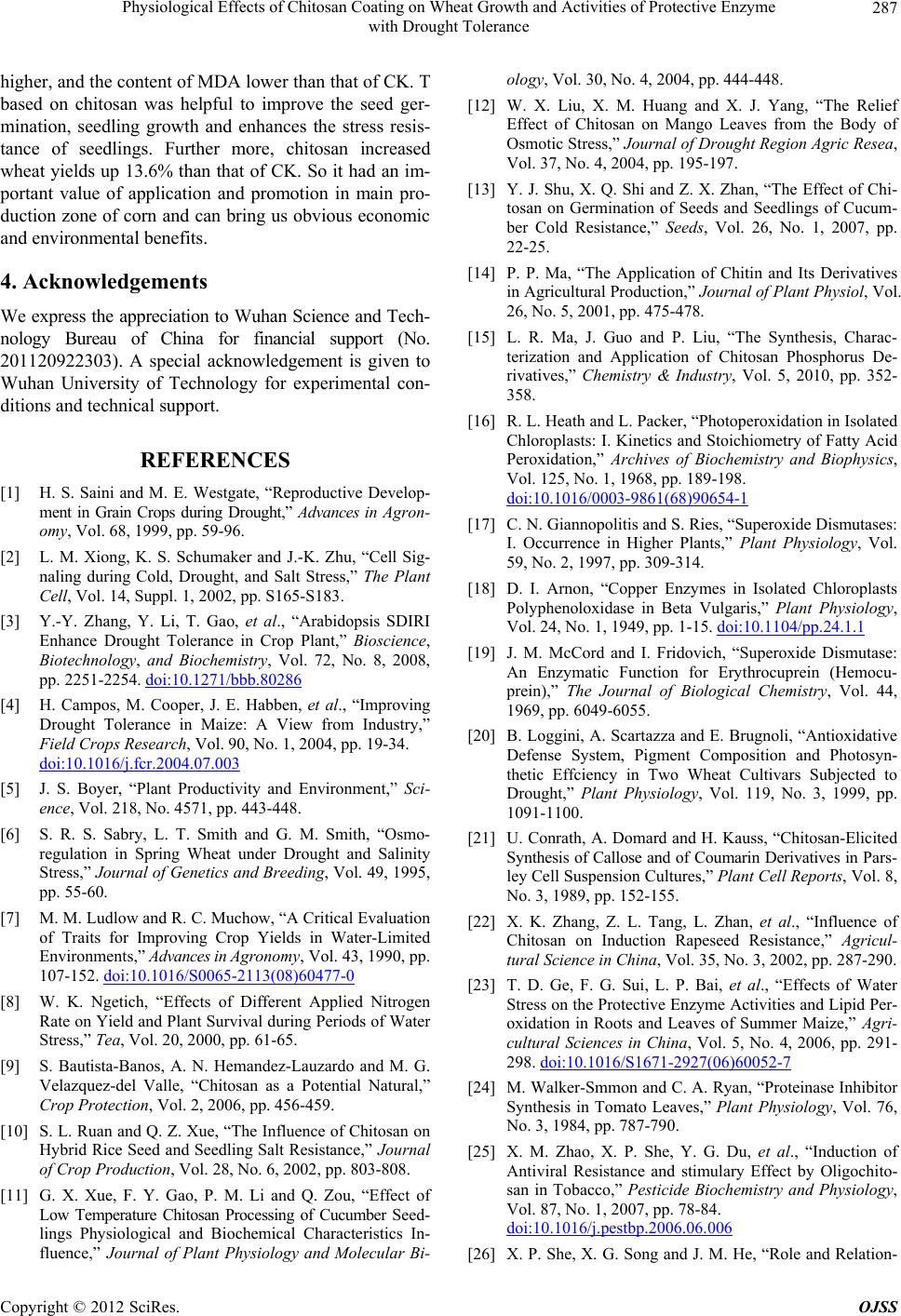
Physiological Effects of Chitosan Coating on Wheat Growth and Activities of Protective Enzyme
with Drought Tolerance
287
higher, and the content of MDA lower than that of CK. T
based on chitosan was helpful to improve the seed ger-
mination, seedling growth and enhances the stress resis-
tance of seedlings. Further more, chitosan increased
wheat yields up 13.6% than that of CK. So it had an im-
portant value of application and promotion in main pro-
duction zone of corn and can bring us obvious economic
and environmental benefits.
4. Acknowledgements
We express the appreciation to Wuhan Science and Tech-
nology Bureau of China for financial support (No.
201120922303). A special acknowledgement is given to
Wuhan University of Technology for experimental con-
ditions and technical support.
REFERENCES
[1] H. S. Saini and M. E. Westgate, “Reproductive Develop-
ment in Grain Crops during Drought,” Advances in Agron-
omy, Vol. 68, 1999, pp. 59-96.
[2] L. M. Xiong, K. S. Schumaker and J.-K. Zhu, “Cell Sig-
naling during Cold, Drought, and Salt Stress,” The Plant
Cell, Vol. 14, Suppl. 1, 2002, pp. S165-S183.
[3] Y.-Y. Zhang, Y. Li, T. Gao, et al., “Arabidopsis SDIRI
Enhance Drought Tolerance in Crop Plant,” Bioscience,
Biotechnology, and Biochemistry, Vol. 72, No. 8, 2008,
pp. 2251-2254. doi:10.1271/bbb.80286
[4] H. Campos, M. Cooper, J. E. Habben, et al., “Improving
Drought Tolerance in Maize: A View from Industry,”
Field Crops Research, Vol. 90, No. 1, 2004, pp. 19-34.
doi:10.1016/j.fcr.2004.07.003
[5] J. S. Boyer, “Plant Productivity and Environment,” Sci-
ence, Vol. 218, No. 4571, pp. 443-448.
[6] S. R. S. Sabry, L. T. Smith and G. M. Smith, “Osmo-
regulation in Spring Wheat under Drought and Salinity
Stress,” Journal of Genetics and Breeding, Vol. 49, 1995,
pp. 55-60.
[7] M. M. Ludlow and R. C. Muchow, “A Critical Evaluation
of Traits for Improving Crop Yields in Water-Limited
Environments,” A d v an ce s i n Agronomy, Vol. 43, 1990, pp.
107-152. doi:10.1016/S0065-2113(08)60477-0
[8] W. K. Ngetich, “Effects of Different Applied Nitrogen
Rate on Yield and Plant Survival during Periods of Water
Stress,” Tea, Vol. 20, 2000, pp. 61-65.
[9] S. Bautista-Banos, A. N. Hemandez-Lauzardo and M. G.
Velazquez-del Valle, “Chitosan as a Potential Natural,”
Crop Protection, Vol. 2, 2006, pp. 456-459.
[10] S. L. Ruan and Q. Z. Xue, “The Influence of Chitosan on
Hybrid Rice Seed and Seedling Salt Resistance,” Journal
of Crop Production, Vol. 28, No. 6, 2002, pp. 803-808.
[11] G. X. Xue, F. Y. Gao, P. M. Li and Q. Zou, “Effect of
Low Temperature Chitosan Processing of Cucumber Seed-
lings Physiological and Biochemical Characteristics In-
fluence,” Journal of Plant Physiology and Molecular Bi-
ology, Vol. 30, No. 4, 2004, pp. 444-448.
[12] W. X. Liu, X. M. Huang and X. J. Yang, “The Relief
Effect of Chitosan on Mango Leaves from the Body of
Osmotic Stress,” Journal of Drought Region Agric Resea,
Vol. 37, No. 4, 2004, pp. 195-197.
[13] Y. J. Shu, X. Q. Shi and Z. X. Zhan, “The Effect of Chi-
tosan on Germination of Seeds and Seedlings of Cucum-
ber Cold Resistance,” Seeds, Vol. 26, No. 1, 2007, pp.
22-25.
[14] P. P. Ma, “The Application of Chitin and Its Derivatives
in Agricultural Production,” Journal of Plant Physiol, Vol.
26, No. 5, 2001, pp. 475-478.
[15] L. R. Ma, J. Guo and P. Liu, “The Synthesis, Charac-
terization and Application of Chitosan Phosphorus De-
rivatives,” Chemistry & Industry, Vol. 5, 2010, pp. 352-
358.
[16] R. L. Heath and L. Packer, “Photoperoxidation in Isolated
Chloroplasts: I. Kinetics and Stoichiometry of Fatty Acid
Peroxidation,” Archives of Biochemistry and Biophysics,
Vol. 125, No. 1, 1968, pp. 189-198.
doi:10.1016/0003-9861(68)90654-1
[17] C. N. Giannopolitis and S. Ries, “Superoxide Dismutases:
I. Occurrence in Higher Plants,” Plant Physiology, Vol.
59, No. 2, 1997, pp. 309-314.
[18] D. I. Arnon, “Copper Enzymes in Isolated Chloroplasts
Polyphenoloxidase in Beta Vulgaris,” Plant Physiology,
Vol. 24, No. 1, 1949, pp. 1-15. doi:10.1104/pp.24.1.1
[19] J. M. McCord and I. Fridovich, “Superoxide Dismutase:
An Enzymatic Function for Erythrocuprein (Hemocu-
prein),” The Journal of Biological Chemistry, Vol. 44,
1969, pp. 6049-6055.
[20] B. Loggini, A. Scartazza and E. Brugnoli, “Antioxidative
Defense System, Pigment Composition and Photosyn-
thetic Effciency in Two Wheat Cultivars Subjected to
Drought,” Plant Physiology, Vol. 119, No. 3, 1999, pp.
1091-1100.
[21] U. Conrath, A. Domard and H. Kauss, “Chitosan-Elicited
Synthesis of Callose and of Coumarin Derivatives in Pars-
ley Cell Suspension Cultures,” Plant Cell Reports, Vol. 8,
No. 3, 1989, pp. 152-155.
[22] X. K. Zhang, Z. L. Tang, L. Zhan, et al., “Influence of
Chitosan on Induction Rapeseed Resistance,” Agricul-
tural Science in China, Vol. 35, No. 3, 2002, pp. 287-290.
[23] T. D. Ge, F. G. Sui, L. P. Bai, et al., “Effects of Water
Stress on the Protective Enzyme Activities and Lipid Per-
oxidation in Roots and Leaves of Summer Maize,” Agri-
cultural Sciences in China, Vol. 5, No. 4, 2006, pp. 291-
298. doi:10.1016/S1671-2927(06)60052-7
[24] M. Walker-Smmon and C. A. Ryan, “Proteinase Inhibitor
Synthesis in Tomato Leaves,” Plant Physiology, Vol. 76,
No. 3, 1984, pp. 787-790.
[25] X. M. Zhao, X. P. She, Y. G. Du, et al., “Induction of
Antiviral Resistance and stimulary Effect by Oligochito-
san in Tobacco,” Pesticide Biochemistry and Physiology,
Vol. 87, No. 1, 2007, pp. 78-84.
doi:10.1016/j.pestbp.2006.06.006
[26] X. P. She, X. G. Song and J. M. He, “Role and Relation-
Copyright © 2012 SciRes. OJSS